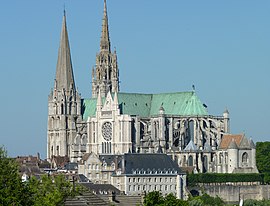Chartres
| Chartres | ||
|---|---|---|

Chartres Cathedral in late-May 2010
|
||
|
||
| Coordinates: 48°27′22″N 1°29′02″E / 48.456°N 1.484°ECoordinates: 48°27′22″N 1°29′02″E / 48.456°N 1.484°E | ||
| Country | France | |
| Region | Centre-Val de Loire | |
| Department | Eure-et-Loir | |
| Arrondissement | Chartres | |
| Intercommunality | Chartres Métropole | |
| Government | ||
| • Mayor (2008-2020) | Jean-Pierre Gorges | |
| Area1 | 16.85 km2 (6.51 sq mi) | |
| Population (2011)2 | 39,273 | |
| • Density | 2,300/km2 (6,000/sq mi) | |
| Time zone | CET (UTC+1) | |
| • Summer (DST) | CEST (UTC+2) | |
| INSEE/Postal code | 28085 / 28000 | |
| Elevation | 121–161 m (397–528 ft) (avg. 142 m or 466 ft) |
|
|
1 French Land Register data, which excludes lakes, ponds, glaciers > 1 km² (0.386 sq mi or 247 acres) and river estuaries. 2Population without double counting: residents of multiple communes (e.g., students and military personnel) only counted once. |
||
1 French Land Register data, which excludes lakes, ponds, glaciers > 1 km² (0.386 sq mi or 247 acres) and river estuaries.
Chartres (French pronunciation: [ʃaʁtʁ]) is a commune and capital of the Eure-et-Loir department in France. It is located 96 km (60 mi) southwest of Paris. This city is well known for its cathedral.
Chartres was in Gaul one of the principal towns of the Carnutes, a Celtic tribe. In the Gallo-Roman period, it was called Autricum, name derived from the river Autura (Eure), and afterwards civitas Carnutum, "city of the Carnutes", from which Chartres got its name. The city was burned by the Normans in 858, and unsuccessfully besieged by them in 911.
During the Middle Ages, it was the most important town of the Beauce. It gave its name to a county which was held by the counts of Blois, and the counts of Champagne, and afterwards by the House of Châtillon, a member of which sold it to the Crown in 1286.
In 1417, during the Hundred Years' War, Chartres fell into the hands of the English, from whom it was recovered in 1432.
In 1528, it was raised to the rank of a duchy by Francis I.
In 1568, during the Wars of Religion, Chartres was unsuccessfully besieged by the Huguenot leader, the Prince of Condé. It was finally taken by the royal troops of Henry IV on 19 April 1591. On Sunday, 27 February 1594, the cathedral of Chartres was the site of the coronation of Henry IV after he converted to the Catholic faith, the only king of France whose coronation ceremony was not performed in Reims.
...
Wikipedia



